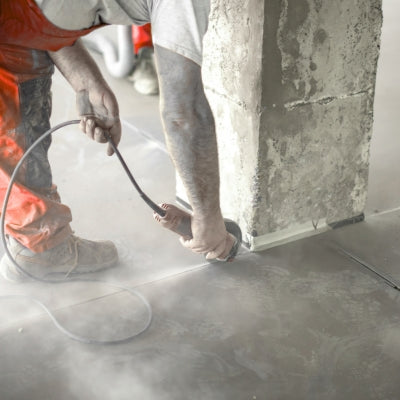
Share
Why make expansion joints in fresh concrete with diamond discs
The industrial flooring in fresh concrete require special care to ensure durability, efficiency and safety in the work areas. Among the most important aspects in laying concrete is the installation of expansion joints , or spaces designed to absorb the expansion and contraction movements of the concrete as the temperature and mechanical stresses vary.
In practice, these joints are created by cutting the concrete with specific tools, and in recent years the use of diamond discs It has established itself as an extremely advantageous solution for various reasons: clean cutting, precision of measurements (for example 2.8 mm or 3.1 mm thickness), operating speed and reduced wear.
In this article we will delve into everything concerning the use of diamond discs for the creation of expansion joints on industrial floors in fresh concrete, explaining the main characteristics of the discs, the advantages, the cutting techniques, the timing, as well as some indications on safety and maintenance. At the end of the reading, if you have further doubts, you can request more information to our specialized technician, so as to obtain personalized support for your project.
1. The importance of expansion joints in fresh concrete industrial floors
The industrial flooring must withstand heavy loads and continuous mechanical stress due to the transit of machinery, vehicles or storage of materials. Furthermore, concrete is a material that, based on thermal and hygrometric conditions, expands and contracts. Without a compensation space, the surfaces risk suffering cracks and even serious structural damage.
This is why the presence of expansion joints it is crucial:
- Stress absorption : The joints prevent structural micro-movements from causing irreparable cracks.
- Reduction of internal stresses : a well-designed cut allows the concrete to 'move' without ruining the continuity of the floor.
- Ease of maintenance : a well-defined and clean joint makes it easier to check and repair the walking surfaces if necessary.
When talking about flooring in fresh concrete , the choice of where and how to place the expansion joints is equally crucial. It is necessary to operate in the right time interval – neither too early, to avoid chipping, nor too late, to prevent spontaneous cracks. New technologies, especially the use of diamond discs , allow you to intervene with greater precision and obtain a thin cut (2.8 mm or 3.1 mm) avoiding future problems of premature deterioration.
2. Why make 2.8mm or 3.1mm expansion joints?
The width of the expansion joint in industrial concrete floors is not arbitrary: it is defined on the basis of Floor features and to the specific expansion needs . Among the most common widths we find 2.8mm And 3.1 mm . It is essential to understand why these measures are often required:
- Adequate freedom of movement : a thickness of a few millimetres still allows for the correct absorption of thermal expansion, without weakening the excess concrete plate.
- Aesthetics and functionality : maintaining a thin joint avoids unsightly joints that are too wide and prevents excessive dirt infiltration or problems in fixing any joining profiles.
- Compatibility with sealant products : many elastomeric sealants or specific resins for expansion joints are optimised for these width ranges.
From a technical point of view, the subtlety guaranteed by diamond discs is advantageous not only for aesthetic reasons but also for practicality and final robustness: it reduces the quantity of cement removed, while ensuring sufficient space for managing the stresses.
3. What are diamond discs and why are they so effective?
THE diamond discs They are cutting tools composed of a circular metal support (generally steel) on the external edge of which abrasive segments containing industrial diamond granules . Diamond, thanks to its hardness (it is the hardest material existing in nature), allows you to cut the cement with extreme efficiency and precision.
The main advantages of using diamond blades are:
- Cutting speed : compared to other systems, the diamond disc allows you to make precise grooves in less time.
- Clean finish : the presence of industrial diamond guarantees a cutting edge regular, essential to reduce the risk of chipping.
- Versatility : there are specific discs for cutting different types of concrete (fresh, cured, reinforced) and also for materials such as asphalt, natural stone or stoneware.
- Durability over time : although subject to wear, quality diamond blades can be used for a long time thanks to the segments which, as they wear, release new diamond crystals exposing cutting surfaces that are always efficient.
In the case of the creation of expansion joints on fresh concrete industrial floors, the precision of the diamond disc Maintaining the desired thickness (2.8 mm or 3.1 mm) is essential to ensure the correct functionality of the joint and the solidity of the flooring in the long term.
4. Composition and characteristics of a diamond disc
To better understand how to work with diamond blades, it is useful to know which ones parts they are composed of:
- Diamond crown or segment : peripheral area where the diamond crystals reside, usually distributed in a metal binder. It is the part responsible for the actual cutting.
- Steel core : base disc on which the diamond segments are welded or fixed with other technologies.
- Central hole : allows the disc to be mounted on specific milling cutters, cutters or cutting machines.
Some characteristics of a good diamond disc :
- Diamond concentration : the higher the concentration of crystals, the more effective the cut (depending on the type of material being worked).
- Binder hardness : influences the rate of wear of the segments. For work on fresh concrete, a softer binder is often preferable, which wears at the right rate, revealing new crystals.
- Segment shape : varies according to the type of cut desired (continuous, segmented, turbo cut).
- Overall diameter : this should be chosen based on the required cutting depth and the machine used.
Pay attention to the disc quality It is essential to avoid breakages or deformations that would compromise the precision of the cutting thickness. Those who work in the industrial sector know that a small defect during cutting can cause significant damage, even from an economic point of view.
5. How to choose the right diamond blade for expansion joints
There Diamond disc choice suitable for making 2.8 mm or 3.1 mm expansion joints on fresh concrete depends on several factors:
- Cutting depth : the disc must have a diameter suitable for reaching the depth required for the joint, which usually varies according to the thickness of the floor. Typically, depths of a few centimetres are expected for industrial floors.
- Concrete type : Fresh concrete still contains moisture and sometimes additives that make it easier or harder to cut. There are blades optimized to work on fresh surfaces with low operating temperatures.
- Armor layer : if the floor is reinforced with steel bars or wire mesh, you need a blade that can cut not only concrete but also any steel it may encounter.
- Working environment : the presence of dust, water or resulting sludge requires considerations on the cutting machines and on discs . Some operations are performed dry, others wet, based on established procedures and available equipment.
- Desired cutting thickness : if you aim to make joints of 2.8 mm or 3.1 mm , the diamond blade must maintain this width constantly along the entire cutting path, without flexing or excessive vibration.
Each diamond blade manufacturer specifies the range of use and the recommended rotation speed . For precision work such as the expansion joint on fresh concrete, it is always important to select a high-end product and turn to a reliable supplier.
6. The ideal time for cutting in fresh concrete
A fundamental aspect for the correct construction of expansion joints is the timing of cutting on concrete. In general, cutting must be performed:
- Not too early : if the concrete is still too fresh and has not reached a minimum consistency, cutting risks causing chipping or collapse.
- Not too late : If the concrete is already shrinking and small surface cracks begin to form, the function of the joint will be compromised.
Normally, the concrete begins its hardening process within the first few hours after pouring. For industrial flooring, the cuts tend to be made within the first 24 hours (often between 8 and 12 hours after execution) or in any case according to the indications of the mix design used. Various factors, such as external temperature, humidity and ventilation, can anticipate or postpone the ideal time.
To understand the right moment, expert operators carry out some hardness test superficial or use direct experience by checking the state of the concrete. A well-made joint in this preliminary phase substantially prevents unwanted cracks and ensures a smooth cutting surface .
7. Cutting techniques: practical tips for an optimal result
Making expansion joints of 2.8mm or 3.1mm in fresh concrete using diamond discs requires method and precision. Here are some practical tips to keep in mind:
- Trace the cutting line : Before starting the machine, it is good practice to mark the exact position of the joints with chalk or a guide wire. Correct tracing reduces errors and improves the cleanliness of the work.
- Check the machine parameters : adjust the rotation speed and feed rate according to the specifications of the diamond blade and the concrete. Too high a speed can cause overheating, while too low a speed reduces productivity.
- Check the cutting depth : set the depth carefully desired depth , usually related to the thickness of the entire concrete slab. If the joint must go completely through the surface layer, make sure to set a uniform and consistent cut.
- Blade Cooling : In situations where wet cutting is recommended or required, it is advisable to maintain a constant stream of water on the blade. Water helps to cool the diamond disc and remove debris, prolonging the life of the tool.
- Avoid excessive vibration : Vibrations can inadvertently widen the cutting thickness, compromising the joint size. A stable machine, with anti-vibration mounts, is a great advantage.
It is essential that the operator is well trained and knows Evaluate the progress of the cut : adjustments during the cut, if well done, can preserve the millimetric precision of the desired joint.
8. Advantages of using diamond discs for the creation of expansion joints
Compared to other cutting methodologies, the diamond discs present a series of advantages relevant:
- Millimetre precision : allows you to obtain joints of 2.8mm or 3.1mm consistently, avoiding waste and subsequent complications.
- Reduced processing times : thanks to their high cutting efficiency, diamond blades reduce the time required to complete the creation of all the joints on the pavement.
- Clean cut : The separation line is clean and sharp, with less risk of breakage at the edges. This is essential to ensure the durability and solidity of the structure.
- Dust reduction (in wet cutting) : When operating wet, dust is significantly reduced, improving the working environment and reducing disc wear.
- Less waste and repair costs : Imprecise cuts can cause defects and early breakages of the pavement, generating extra costs for restoration. With diamond technology, the risk is significantly lower.
- Versatility : a good quality diamond blade can be used on different materials, allowing the company to use the same equipment on other construction sites or processes.
For a company specialized in industrial floor cutting , investing in high-level diamond blades and dedicated machinery represents a competitive advantage and a way to offer customers a highly professional service.
Request more information from our specialized technician
If you want to get personalized support on creation of expansion joints with diamond discs for your industrial flooring in fresh concrete , it is essential to compare yourself with a expert technician that can evaluate all the variables of your project.
Our team has qualified professionals capable of:
- Analyze your job site and recommend the best cutting procedure.
- Choose the most suitable diamond blade and machine, based on the characteristics of the concrete and the desired cutting depth.
- Provide a detailed plan to optimize time and costs, ensuring flawless results.
- Provide safety tips and maintenance procedures to increase the longevity of machinery and tools.
Contact us now for additional information or to schedule an appointment with our specialized technician. We will guide you step by step, from the design phase to the execution on site, ensuring that your expansion joints are made with the utmost precision.
Write to sales@lanordsrl.it



